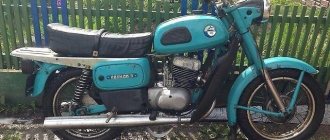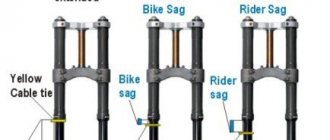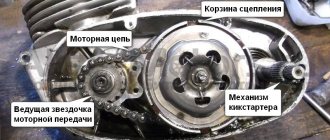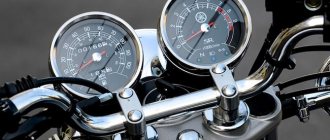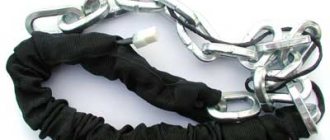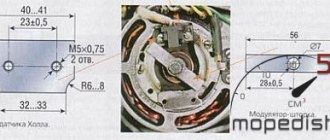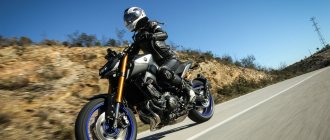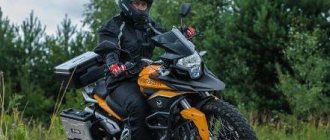| "Minsk" M106 | |
| general information | |
| Manufacturer | Minsk Motorcycle and Bicycle Plant |
| Components | |
| Engine | Single-cylinder two-stroke 123 cm3 9 hp at 5,500 rpm. |
| Lubrication system | together with fuel |
| Cooling system | air |
| Specifications | |
| Maximum load, kg | 150 |
| Maximum speed, km/h | 85 |
"Minsk" M106
- a light road two-seater motorcycle from the Minsk motorcycle family produced by the Minsk Motorcycle and Bicycle Plant (BSSR, Minsk, modern name - Motovelo OJSC). Produced from 1971 to 1973. The predecessor is the Minsk M105 model, the successor is the Minsk MMVZ-3.111.
Device
The M106 motorcycle model is a further development of the previous M105 model. The changes also concern the appearance - the gas tank has acquired a more modern shape and can hold 12 liters of fuel. For the first time, the M-106 motorcycle was equipped with a trunk, which became a mandatory accessory for Minsk motorcycles.
Engine
The engine is single-cylinder, air-cooled and dual-channel return blown. Aluminum alloy cylinder head.
The engine on the M106 model was modified: engine power was increased due to better cylinder filling, the use of a new muffler and a K-36S carburetor with a diffuser diameter of 24 mm, resulting in a power of 9 hp. With. at 5,500 rpm. The engine requires fuel from a mixture of oil and gasoline in a ratio of 1:25.
Transmission
The gearbox is four-speed. The gear shift mechanism is foot-operated. Multi-disc clutch in oil bath. The drive to the rear wheel is by chain, with the main drive protected by stamped casings and rubber chain covers.
Chassis
The frame is tubular, closed, reinforced (in relation to M105). The wheel hub bearings have been increased from No. 201 to No. 202. The front fork is of a telescopic type with hydraulic shock absorbers. The rear suspension is pendulum type with hydraulic shock absorbers.
Legendary motorcycles of the USSR (12 photos)
Author: Cinzano
06 April 2014 00:08
Tags: USSR motorcycle
43167
12
I would like to start with those who are older. I think most bikers at some point, perhaps even in childhood, tried these motorcycles, learned to ride them, knew where to climb if it didn’t start or stalled. In general, despite all the disadvantages of the domestic motorcycle industry, I think I have good memories of them...
0
See all photos in the gallery
1) Good old (surely Reference: Minsk Motorcycle and Bicycle Plant was founded in 1945 on the basis of exported equipment from DKW factories of defeated Germany. Starting with bicycles, already in 1951 Minsk residents put the first motorcycle on the assembly line. Since then, little has changed. Well except that a 250 cc engine appeared. The first Belarusian “bike” was the Minsk M1A, which had many “relatives” not only in the USSR but also abroad. The “ancestor” of the motorcycle was developed by the Germans in 1939. The DKW RT125 turned out to be so successful that Under different names, analogues of this motorcycle were produced in 7 countries around the world, including the USA, England and Japan. Well-known to everyone) MINSK.
0
0
On the eve of the October holiday, the team of the Minsk Motorcycle and Bicycle Plant produced the first industrial batch of new road motorcycles "Minsk", designated MMVZ-3.111, and from the first day of this year (1974) began their serial production. When developing a new model, the designers were faced with the task of creating a motorcycle with a modern look, more reliable and durable compared to its predecessor, the M-106. I think that motorcyclists will appreciate the external shape. Let’s just say that they were chosen as a result of a lot of work, which was carried out by the plant’s designers together with specialists from VNIIMotoprom, after a thorough study of modern domestic and best foreign models. To make the motorcycle look elegant, the artists proposed a combined paint job in two colors - black and cherry. Despite the significant differences between the Minsk and the M-106, it was possible to ensure wide interchangeability of their components and parts, reaching 83.7 in percentage terms.
0
2) Sunrise 3M (2M).
0
Motorcycle Voskhod is a representative of the classic road two-wheeled all-terrain vehicles of the Soviet era! The design is extremely simple, and the motorcycle is completely repairable, which guarantees the unpretentiousness and reliability of the machine in any situation. The Voskhod motorcycle is produced by the plant named after. Degtyarev (ZID) and is an example of the subsequent development of the K-175 (Kovrovets) model, which was produced until 1965, starting in 1957. Undoubtedly, like any equipment, the Voskhod motorcycle has a number of pros and cons. The most compelling argument in favor of Voskhod is, perhaps, its relatively low price and the ability to be repaired almost “on the fly.” The wide distribution of the motorcycle throughout the country and the developed network of suppliers of spare parts for domestic motorcycles guarantee that the owner of Voskhod will never be faced with the question of finding and replacing a failed part. By the way, Voskhod breakdowns do not happen very often and in most cases are due to the negligence or oversight of the owner. Therefore, in order not to stall somewhere in the middle of the “pea” field, there must be a masterful attitude and constant control towards the motorcycle. All Voskhods prefer to “feast on” 76th gasoline (and now 80th) and, naturally, with a good portion of oil. With the correct carburetor and ignition settings, Voskhod turns out to be a very economical motorcycle. And now about the main thing... About the “show off”. If you are looking for a motorcycle to show off in front of your friends or to ride like a breeze through the evening city to the envy of everyone with a pretty blonde in the back seat, then the Voskhod motorcycle is clearly not for you. The motorcycle is unremarkable, and only a true master can make something interesting out of it. So if your hands grow from the right place and you can hold the instrument firmly, feel free to buy Voskhod; if not, leave this matter to the professionals! When driving on the highway, you need to be extremely careful - light weight and constant characteristic vibration can play a cruel joke at speeds over 90 km/h. You shouldn’t wishful thinking: if you’ve dreamed of buying an expensive American cruiser all your life, over time you’ll definitely buy it. But before that, it would be nice to practice well on the “indestructible” Voskhod. The Voskhod motorcycle is perfect for developing driving skills, training and will accustom you to a bright, full-fledged motorcycle life! Motorcycle Voskhod 2 replaced the first model. Although the motorcycle has become a little more powerful, it is practically no different from its predecessor. The changes affected only the appearance. Voskhod 2 acquired new headlights and round direction indicators, as well as a rear light. The electronic contactless ignition system was improved and new light signaling devices were added. Minor changes in Voskhod 2 concerned an increase in power (by 0.5 hp) and torque (by 1 Nm) compared to the old model, which actually remained unnoticeable, but still a pleasant addition. The modernized Voskhod 2 motorcycle became faster and could reach speeds of up to 95 km/h, although it gained a couple of kilograms in weight. The second Voskhod was replaced in 1977 by the modernized Voskhod 2M. The motorcycle engine retained the same volume, but became more powerful (13 hp) and “torque” (16 Nm at 5600 rpm). This was achieved by improving the configuration of the channels in the cylinder, crankcase and a new head (the compression ratio was increased to 9.2). Now the new Voskhod 2M could easily “eat” high-octane 93rd gasoline, along with the usual A-76. The changes affected the motorcycle's suspension: the front fork was changed, the shock absorbers were improved and the diameter of the pipes was increased. The fork travel was 160 mm. Voskhod 2M became faster by 10 km/h (max. speed 105 km/h) and heavier (121 kg). Following the 2M, a new motorcycle was released - Voskhod 3. The model, naturally, became much better than previous generations. Voskhod 3 was equipped with a large fuel tank and rear shock absorbers with increased energy capacity. The shock absorbers are located at an angle of 12°, which allows the stroke to be increased to 105 mm. A new intake system has been installed. Voskhod 3 was equipped with a new upgraded braking system, in which the diameter of the brake drums was increased to 160 mm (from 125 mm). The motorcycle was equipped with new wheels with abrasion-resistant tires and a 7-volt generator. The driver's seat has become more comfortable. The maximum speed of Voskhod 3 remained the same as the previous version - 105 km/h, and the weight increased to 125 kg. In 1984 Voskhod 3M was released. The motorcycle was very reliable and well made, and was produced until 1992. 3M received 12-volt equipment, a reflective tail light and a new FG-137B format headlight with a “European” light diffuser, and the cylinder fins became larger, which increased the engine cooling surface. The instrument panel fits harmoniously into the design and is located above the headlight. The panel contains: speedometer, ignition, indicators of direction indicators, high and low beam. The Voskhod ZM motorcycle received a special brake lining wear indicator. The front shock absorbers were equipped with new rubber corrugated covers. And also, Voskhod ZM became the owner of a new profiled front wheel guard. The motorcycle was equipped with a modernized kickstarter system with a folding pedal, rear-view mirrors and folding driver's footrests were added. The maximum speed is 105 km/h, and the total weight is 122 kg. In 1989, another modification appeared - Voskhod 3M-01. The appearance of this motorcycle has remained virtually unchanged. Only the engine, with a reed valve, has undergone serious modifications. The engine featured one exhaust port and a cylinder with five-channel scavenging. Thanks to the installed reed valve at the inlet, it was possible to reduce fuel consumption to 4.2 liters per hundred kilometers. The power of the power unit has increased to 14 hp, and the maximum torque has increased to 17 Nm at 5500 rpm. The Voskhod 3M-01 motorcycle has one muffler, the steering wheel has become wider and more comfortable. The 3M-01 model was followed by the release of motorcycles under the Sova brand.
0
3) IZh Planet (Jupiter) 5.
0
IZh motorcycles have been produced since 1929 in the city of Izhevsk. The IZH Planeta-5 motorcycle has been produced since 1987. In its appearance and in all its characteristics, IL Planet-5 is significantly superior to all its predecessors. The motorcycle has acquired a stylish, more modern look: the instruments now have all the Izh Planet 5 designations; in case of a certain malfunction, a certain warning lamp will light up. All the shields and tank of the new IZH Planet-5 look simply impeccable. The saddle now looks much nicer than in previous models, and it has become much more comfortable. The power produced by the IZH Planet-5 engine reaches 22 horsepower. And in terms of torque in this class there is simply no equal: IZH Planet-5 will slowly puff at idle, but will climb any mountain. A very big advantage of IZH Planet-5 is that it has a single-cylinder engine, while two-cylinder engines are always capricious or one of their cylinders often fails. IL Planet-5 has relatively good characteristics in terms of efficiency: fuel consumption per 100 km at a speed of 90 km/h does not exceed 5 liters. As for the maximum speed of IZH Planet-5, it reaches 120 km/h. The motorcycle can be used alone or with a side trailer. The rear suspension of the IZH Planet-5 is adjustable depending on the road characteristics and the load on the motorcycle. Thanks to all its qualities, IZH Planet-5 has a wide range of owners and fans, both in the city and outside the city.
0
The history of motorcycles of the IMZ (Ural) brand began in 1940. The basis was the BMW R71 Motorcycle, which was ordered to be carefully copied. For these purposes, 5 motorcycles were purchased, to maintain secrecy, in Sweden - and reproduced. Three factories at once began manufacturing the motorcycle, which received the M-72 index, in 1941 - in Moscow, Leningrad and Kharkov. The plant assembled the Ural motorcycle for the Russian army, on which the Konkurs-M anti-tank missile system was installed. But the outbreak of war forced the evacuation of the equipment of these factories far to the east, to the Ural city of Irbit, where the production of these motorcycles was quickly launched. But still, the needs of the Red Army for motor vehicles during the Great Patriotic War were met mainly through lend-lease supplies from the USA and Great Britain. In particular, the Harley-Davidson WLA motorcycle was exported to the United States until 1945. However, after the start of the Great Patriotic War, work to expand the production of the M-72 motorcycle began to intensify. But the offensive of the German troops was rapid: on October 20, 1941, Moscow was declared in a state of siege, and the next day, October 21, the Evacuation Council under the Council of People's Commissars of the USSR decided to transfer the Moscow Motor Plant and the ZIS and KIM Shops associated with motorcycle production to the Urals to city of Irbit. They also sent specialists from Kharkov, Taganrog and Leningrad to the distant Ural town. The first train arrived in Irbit on November 17, 1941. The plant, which from that time on became the Irbit Motorcycle Plant (IMZ), was located on the territory of a former brewery. Despite all the difficulties, on February 25, 1942, the first batch of M-72 motorcycles was produced from engines brought from Moscow. M-61, M-63, M-66
0
A motorcycle with the M-61 index, assembled in small batches since 1957, completely filled the assembly production in 1960 and was built until 1963. It became the first to receive the name “Ural”. Since 1961, the M-62 model with a new camshaft and automatic ignition timing mechanism was assembled in parallel. Engine power increased to 28 hp. The modernized gearbox - with gear clutches instead of cam clutches - was unified with motorcycles from the Kyiv Motor Plant (KMZ). In addition, the suspension travel was increased and the shape of the front fork housings was changed. In 1955, together with NAMI, the development of an original microcar of a carriage layout called “Belka” began: the engine was borrowed from a motorcycle, but received forced cooling. In 1959, factory designers developed the Ogonyok all-terrain vehicle. From 1965 to 1971, the M-63, patrol, Cross-650, and Strela motorcycles, which were at the level of the best world models, were mastered and went into series. The crowning achievement of IMZ’s development in the pre-perestroika period was November 22, 1985, the day when the 2,000,000th motorcycle rolled off the factory assembly line. The next motorcycle in the series of serial Irbit models was the M-63, which appeared in 1963 and completely replaced the previous car from 1965, which was given the name “Ural-2”. For this motorcycle, a new frame was developed with a pendulum rear suspension that received hydraulic shock absorbers. The shape of the gas tank has also changed, and at the same time its capacity has increased. The exhaust system also received a new form. This car turned out to be a long-liver, produced until 1980. The M-66 Ural-3 motorcycle, which appeared in 1971, was the son of further evolutionary changes in the design of Irbit motorcycles. Externally, the car remained virtually unchanged, except that the direction indicators were noticeable. Engine power increased to 32 hp; for the first time, a full-flow oil filter with a replaceable element was introduced into the engine lubrication system. This car was built until 1975, but based on its engine, by 1973 a significantly redesigned chassis with a combined driver and passenger seat was ready. The debutant received the name “Ural” M-67. Other innovations of this machine include 12-volt electrical equipment and a two-cam front brake. In 1976, it was replaced by an even more modern version - the Ural M 67-36, which received a 36-horsepower engine with a constant displacement of 650 cm3.
0
5) JAWA 350(250).
0
0
In 1973, specialists from the YAVA national enterprise developed a new motorcycle model - 634, it was produced only with a 350 cc engine. see. The design of the power unit of JAVA motorcycles that existed until now was so successful that it is also in the new mod motorcycle. 634 it was preserved. Two cylinders, arranged in a row across the axis of the motorcycle, are tilted forward by 25°. The location of the crank mechanism, gearbox and engine forward gear in the common engine crankcase remains the same as in previous models. However, to improve operational reliability and increase service life, they were slightly changed. In the articulation of the piston pin with the connecting rod, instead of a bronze bushing in the upper head of the connecting rod, a needle bearing with INA needles was used, secured against axial displacement. An INA bearing with a cage was installed in the lower head of the connecting rod, fixed in the axial direction with hardened steel washers. The crankshaft middle bearing can be re-lubricated with grease. A change and design improvement can be considered the use of a double bushing chain in the front chain drive (instead of the previous simple one). The double chain has a longer service life and does not elongate or cause shock to be transmitted to the gear pairs of the transmission. Toothed couplings on gearbox gears were already introduced on motorcycles models 623 and 633 and on mod. 362 Californian IV. The most characteristic feature of the motorcycle of the new model 634/4 is a completely new frame with an oscillating fork, using which the arrangement of other components and parts of the chassis has been changed. Since time immemorial, Java motorcycles have been started using a common start and gear lever. However, now a cold engine starts after several cranks, and a warm engine starts after one press on the pedal. The Java's semi-automatic clutch disengages when the gear shift lever is moved. For those who use a clutch lever, this makes it necessary to immediately release the lever as soon as the corresponding gear is engaged. Once accustomed to this somewhat peculiar driving experience, it is easy to get used to the gear changes. It would be nice for this car to have five gears, since it does not have a wide enough range of the required number of revolutions. To achieve good acceleration during acceleration, you have to use an increased number of revolutions. The engine's best torque is between 3,000 and 5,250 rpm. However, up to a speed of 90 km/h the motorcycle accelerates on par with an average car. The maximum speed of the motorcycle according to the passport is about 120 km/h, but on a well-run-in motorcycle it is not difficult to reach a speed of 130 km/h. The car behaves best at speeds of 110-115 km/h, although it vibrates a little while driving and these vibrations are felt on the footrests. Fuel consumption is about 1 liter per 16 km, so in relation to the tank volume (17 liters), the Java has a sufficient range. Behavior of the car on the move The motorcycle has very good driving properties. It is extremely stable and easy to drive even on bad roads. Good driving properties are partly achieved thanks to the front fork, which is quite rigid and can withstand rough road conditions well. Although it should be noted that Barum tires, designed for the entire service life of the motorcycle, do not have the necessary grip, and therefore you have to resort to an appropriate riding style. In the city, the Java has proven itself to be a well-handled vehicle, and this is supported positively by its curb weight of 166 kg. In terms of comfort, this Java motorcycle model is at a fairly high level for a motorcycle in its class. The saddle is quite rigid and does not cause any complaints of pain even on long rides. As already mentioned, the front fork is stiff, but does a good job of absorbing big and small impacts. Adjustable shock absorbers at the rear allow you to overcome uneven roads even under heavy loads. Due to its size, the motorcycle is ideal for two people.
Source:
Related links:
- Forgotten by time but not erased from memory
- Doesn't like women driving...+ Double strike.
- How MiG-17 fighters shot down supersonic F-105s
- “Rock in the USSR” Photographer: Igor Mukhin
- Endurike rides 2014
Tags: USSR motorcycle
Do you like to remember how things were before? Join us, let's feel nostalgic together:
301 32 269
Liked
269 1
75
Partner news
Technical specifications
| Length, mm | 1 960 |
| Width, mm | 660 |
| Height, mm | 1 000 |
| Base, mm | 1 230—1 255 |
| Ground clearance, mm | 135 |
| Maximum load, kg | 150 |
| Dry weight, kg | 100 |
| Max. speed, km/h | 85 |
| Average fuel consumption, l/100 km | 3,5-4 |
| Cylinder diameter, mm | 52 |
| Piston stroke, mm | 58 |
| Engine displacement, cm3 | 123 |
| Compression ratio | 8.5 |
| Engine power, l. With. | 9 |
| Speed at max. power rpm | 5 500 |
| Carburetor | K-36S |
| Air filter | contact-oil |
| Fuel | gasoline A-76 |
| Gas tank capacity, l | 12 |
| Motor transmission | Chain PV-9.525-1200 |
| Gear ratio | 2,75 |
| Clutch | multi-disc, oil bath |
| Number of master disks | 4 |
| Transmission | 4-speed |
| Gear ratios | I - 2.92, II - 1.97, III - 1.33, IV - 1.00 |
| main gear | closed circuit PR-12.7-1888-2 |
| Gear ratio | 2,67 |
| Wheels (hubs) | stamped |
| Tires | 65-484 (2.50-19″) |
| Saddle | double, pillow type |
| Generator | G-411 |
| Ignition coil | B-300 |
| Ignition timing (mm to TDC) | 3,2 — 3,7 |
| Headlight bulb | 32×21 |
| Stop signal | FP-230 |
| Direction indicator | absent |
| Speedometer | SP-115 |
| Signal | S-34 |
| Light switch | P-200 |
An era of stability
Next model
In 1956, the Minsk plant produced a modernized version of the M1A - M1M. It had a softer ride than its predecessor, which is why in areas with many holes and potholes it could lose stability, which sometimes led to a fall.
Motorcycle M1A
This is one of the shortcomings. The advantages include an increased maximum load and speed, allowing the speedometer to approach the mark of 75 km/h. Also, electrical equipment was used on this motorcycle for the first time in the series. In general, that's all.
Model “M103”
The production of “M1M” lasted five years - from 1956 to 1961. The shift arrived in 1962. It became a generalization of many years of experience of the Minsk plant. The suspension was made stiffer so that riders would no longer fall on bad or simply uneven sections of the road. We changed the filters in the engine to more modern ones, which significantly increased its lifespan.
Motorcycle Minsk M-103
Load capacity and speed were left, in general, unchanged. Fans of the motorcycle were upset that the single-seater design of the device was also left unchanged. However, for this model it was supposed to be possible to purchase an additional seat for a passenger for an additional fee. But who needs it? It would be better if everything was equipped right away, at the factory, as it should be,” Soviet users were indignant.
Model “Minsk”
The next generation change occurred in 1964. Actually, this particular motorcycle had the word “Minsk” in its name; previous versions were called that by the people, for the sake of clarity and simplicity. Compared to its predecessors, it turned out to be more stylish, or something
When designing it, considerable attention was paid to appearance. Engine power also increased to 5.5 hp
And, lo and behold, for the first time on this model there was also room for a passenger.
New word. "M105".
This particular motorcycle can be considered an evolution in the development of this series. A four-speed gearbox was used for the first time. Engine power increased to a respectable 7 hp, which made it possible to reach a speed of 80 km/h. Also, for the first time, a brake light was installed to increase road safety, and a light bulb was attached to the speedometer for illumination. Production lasted until 1971.
Now also with a trunk. “M106”
In addition to the rear trailer for payloads, the tank volume has also increased - 12 liters. And the engine power had now increased to 9 hp, and now the motorcycle could accelerate to a speed of 85 km per hour. The weight of the car was now exactly a hundredweight.
Hipster. “MMVZ-3.111”
Having replaced the previous model in 1973, MMVZ-3.111 stood out for its modern and fashionable appearance. The speed increased to a respectable 95 km/h. A light switch for high and low beams, as well as a direction indicator, appeared.
Motorcycle Minsk MMVZ 3.111
This motorcycle received the “USSR Quality Mark”. A “Sport” model was also released, which had a 12 hp engine.
Cosmetic changes. “MMVZ-3.115”
As the name suggests, no special innovations were introduced. Only the speedometer and switch were moved into separate housings, and a new muffler and headlights were installed. Year of manufacture: from 1976 to 1980.
Logical progress. “MMVZ-3.112”
Expert opinion Isaac Yakovich Zelder Soviet astrophysicist, physical chemist, Doctor of Physical and Mathematical Sciences, Academician of the USSR Academy of Sciences, designer, engineer. Hero of Socialist Labor of the USSR.
Yes, this is not a mistake, the next model had a smaller number in its name than the previous one. Some factory marking features.
This motorcycle was externally similar to its predecessor, but was superior to it in a number of parameters. He “lost” the weight by 7 kg, while increasing the load capacity by 10. He became more comfortable to ride. The speed remained the same, but the engine power was now a confident 12 hp. Produced from 1980 to 1995. A number of modifications were made, which were mainly intended for rural areas.
An excerpt characterizing Minsk M106
- Well, what, young man? - he said, sighing and looking into Rostov’s eyes from under raised eyebrows. Some kind of light from the eyes, with the speed of an electric spark, ran from Telyanin’s eyes to Rostov’s eyes and back, back and back, all in an instant. “Come here,” Rostov said, grabbing Telyanin by the hand. He almost dragged him to the window. “This is Denisov’s money, you took it...” he whispered in his ear. – What?... What?... How dare you? What?...” said Telyanin. But these words sounded like a plaintive, desperate cry and a plea for forgiveness. As soon as Rostov heard this sound of the voice, a huge stone of doubt fell from his soul. He felt joy and at the same moment he felt sorry for the unfortunate man standing in front of him; but it was necessary to complete the work begun. “People here, God knows what they might think,” Telyanin muttered, grabbing his cap and heading into a small empty room, “we need to explain ourselves...” “I know this, and I will prove it,” said Rostov. “I... Telyanin’s frightened, pale face began to tremble with all its muscles; the eyes were still running, but somewhere below, not rising to Rostov’s face, sobs were heard. “Count!... don’t ruin the young man... this poor money, take it...” He threw it on the table. - My father is an old man, my mother!... Rostov took the money, avoiding Telyanin’s gaze, and, without saying a word, left the room. But he stopped at the door and turned back. “My God,” he said with tears in his eyes, “how could you do this?” “Count,” said Telyanin, approaching the cadet. “Don’t touch me,” Rostov said, pulling away. - If you need it, take this money. “He threw his wallet at him and ran out of the tavern. In the evening of the same day, there was a lively conversation between the squadron officers at Denisov’s apartment. “And I’m telling you, Rostov, that you need to apologize to the regimental commander,” said a tall staff captain with graying hair, a huge mustache and large features of a wrinkled face, turning to the crimson, excited Rostov. Staff captain Kirsten was demoted to soldier twice for matters of honor and served twice. – I won’t allow anyone to tell me that I’m lying! - Rostov screamed. “He told me I was lying, and I told him he was lying.” It will remain so. He can assign me to duty every day and put me under arrest, but no one will force me to apologize, because if he, as a regimental commander, considers himself unworthy of giving me satisfaction, then... - Just wait, father; “Listen to me,” the captain interrupted the headquarters in his bass voice, calmly smoothing his long mustache. - You tell the regimental commander in front of other officers that the officer stole... - It’s not my fault that the conversation started in front of other officers. Maybe I shouldn’t have spoken in front of them, but I’m not a diplomat. Then I joined the hussars, I thought that there was no need for subtleties, but he tells me that I’m lying... so let him give me satisfaction... - That’s all good, no one thinks that you’re a coward, but that’s not the point. Ask Denisov, does this look like something for a cadet to demand satisfaction from the regimental commander? Denisov, biting his mustache, listened to the conversation with a gloomy look, apparently not wanting to engage in it. When asked by the captain's staff, he shook his head negatively. “You tell the regimental commander about this dirty trick in front of the officers,” the captain continued. - Bogdanych (the regimental commander was called Bogdanych) besieged you. - He didn’t besiege him, but said that I was telling a lie. - Well, yes, and you said something stupid to him, and you need to apologize. - Never! - Rostov shouted. “I didn’t think this from you,” the captain said seriously and sternly. “You don’t want to apologize, but you, father, not only before him, but before the entire regiment, before all of us, you are completely to blame.” Here's how: if only you had thought and consulted on how to deal with this matter, otherwise you would have drunk right in front of the officers. What should the regimental commander do now? Should the officer be put on trial and the entire regiment be soiled? Because of one scoundrel, the whole regiment is disgraced? So, what do you think? But in our opinion, not so. And Bogdanich is great, he told you that you are telling lies. It’s unpleasant, but what can you do, father, they attacked you yourself. And now, as they want to hush up the matter, because of some kind of fanaticism you don’t want to apologize, but want to tell everything. You are offended that you are on duty, but why should you apologize to an old and honest officer! No matter what Bogdanich is, he’s still an honest and brave old colonel, it’s such a shame for you; Is it okay for you to dirty the regiment? – The captain’s voice began to tremble. - You, father, have been in the regiment for a week; today here, tomorrow transferred to adjutants somewhere; you don’t care what they say: “there are thieves among the Pavlograd officers!” But we care. So, what, Denisov? Not all the same?
